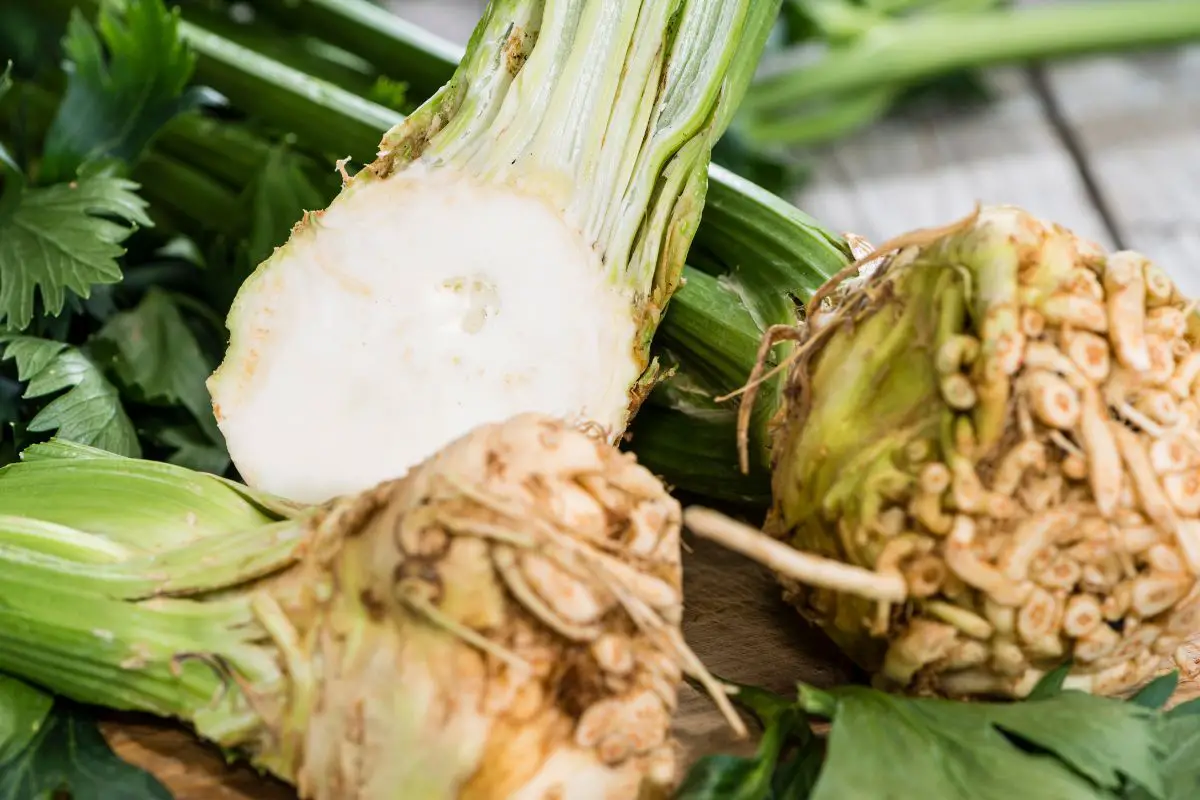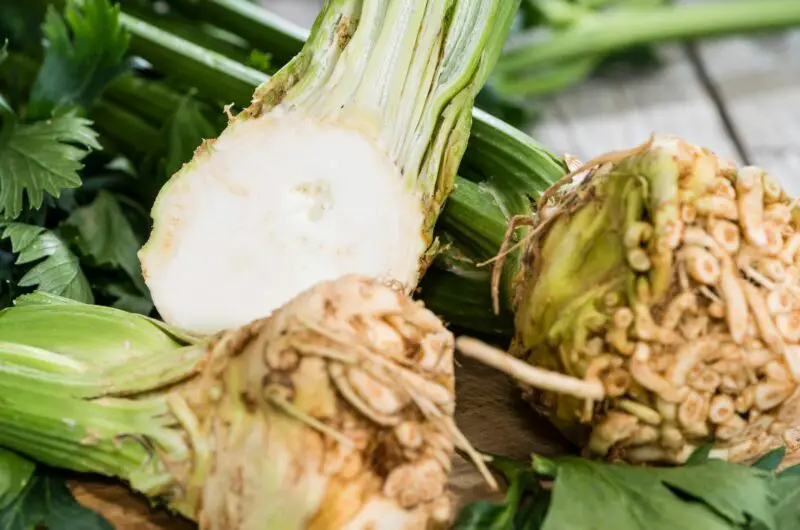When it comes to root vegetables that are used in cooking around the world, there might not be a more overlooked vegetable than celeriac.
Often forgotten in favor of its more popular root counterparts like carrots and potatoes, this vegetable has still managed to find a niche in cooking that few other vegetables can fill.
However, that niche also makes it difficult to replace if you’re cooking a recipe, and suddenly find that you don’t have any or enough of this vegetable to go around for your dish!
What do you do? Are there any ways to substitute this veggie and its distinct, earthy flavors?
Why yes. There are! Celeriac is a pretty unique vegetable, but it’s not completely irreplaceable. Especially if you know what qualities you need to be looking for!
In this guide, not only will we show you some of the best ingredients that you can replace celeriac with, but also some of those key characteristics that you’ll be looking to replace in the first place!

What Is Celeriac?
Before we get any deeper into this topic, we should probably first explain what makes celeriac such a useful vegetable to use when cooking.
That way, not only will you have a deeper appreciation for this food, but also know what qualities you need to be looking for in a substitute!
As we mentioned in the introduction, celeriac is a root vegetable, and is particularly popular across Europe, as it is grown with celery. Celeriac is the root of the celery vegetable!
Celeriac looks like a rough root if you buy it with its tough skin on. However, once you have chopped or peeled off the outside, you will see an off-white inside that is firm to the touch, and can be easily sliced or peeled from there.
In terms of its flavor, celeriac has a unique combination of a root that is sweet, whilst being simultaneously quite nutty and earthy as well, making it a strange outlier, when, comes to flavors in the root vegetable world, having both the sweetness of roots like carrots, but also the savory earthy flavors of something like potatoes.
It also has a very high moisture content, being a root vegetable, so you’ll often find that they are a great way of bringing moisture into a recipe, without having to add any extra water.
Celeriac is often cooked in stews or steamed down so that it can be served alongside other foods, but it is also very popular to simply eat it sliced and raw, either as dipping chips/fries, or
Qualities In A Substitute
So, if you’re looking for a substitute, what are some of the key features that a good substitute should have?
- A celeriac substitute should have a strong flavor that is both sweet and earthy.
- Can be eaten raw, or added to stews or soups.
- Must have a firm texture when eaten raw, or soften up once it had been cooked.
We will be taking all of these factors and more into account when deciding on what constitutes a good substitute.
1. Parsley Root
Starting with arguably the best substitute veggie for celeriac, we have parsley roots.
Parsley is a herb that many people will be familiar with.
However, what many people don’t realize is that the root of parsley is also edible in itself, looking an awful lot like a parsnip in many ways, although parsley root is generally thinner and more pointed.
It’s widely agreed that parsley root shares several key qualities in common with celeriac.
The somewhat sweet, yet earthy flavor of parsley root, makes it a pretty good fit in terms of its flavor profile.
onsidering that parsley root is added to many similar recipes that you would normally use celeriac for, this is a pretty fair comparison in terms of how it cooks, too.
Parsley Root can even be chopped into fries, and used as a dip, just like raw celeriac can.
The only issue you may run into is that parsley root tends to be a lot smaller than celeriac, so you’re going to need more to make up the same amount.
The flavor of parsley root, while very similar, is also slightly stronger, meaning that you’ll need to use less parsley root than you would celeriac in a given recipe.
Parsley root is also a relatively obscure root vegetable, even more so than celeriac. However, if you can find it, it is a phenomenal substitute to keep in your pantry!
2. Celery
We touched on how celeriac is just the root of a celery vegetable.
So, if we’re looking to replace celeriac with a vegetable, why not consider the vegetable that grows out of it?
Celery has a somewhat similar flavor to celeriac, although many people will not the bitter flavor you’ll find in celery. It’s crunchy flavor that you get while eating it fresh, which is what makes it so popular for dipping in its raw state.
Not only that, but celery is likely to be much easier to find and purchase in a grocer or supermarket than celeriac is, making this a readily available substitute as well.
The main issue with using celery as a substitute is that its flavors, while similar to celeriac, are more bitter, meaning that you’ll likely end up with a very different flavor in your recipe, or use it in smaller quantities.
3. Butternut Squash
Is there a greater symbol of the harvest than a good butternut squash?
They’re also a pretty go substitute for celeriac, it turns out!
Butternut squash has a distinct nuttiness to it that many other vegetables don’t have. Add to that a sweet flavor too, and the flavor profile is surprisingly similar to that of celeriac.
Not only that, but the texture is quite similar too. Butternut squash can be eaten raw or chopped up for dipping into condiments. Or, it can be cooked in a similar way to chopped or grated celeriac.
The water content is a little lower, but not so much that it would affect the rest of your ingredient lists, outside of a splash of water.
Of course, the color could be an issue. Whatever recipe you’re cooking is going to turn at least a little more orange after butternut squash has been added to the mix!
However, if you don’t mind the added color, butternut squash s a great substitute for pretty much any situation.
4. Turnips
When it comes to ingredients for soups and stews, there probably isn’t a vegetable as popular as turnips!
… Okay, that is hard to quantify. But the point stands, if you’re looking for stew-based recipes that celeriac is often served with, chances are that turnips are going to be one of the best substitutes that you can find!
When plucked from the grounds and cleaned, turnips look like small, miniature potatoes, albeit with an often more red hue to them. When peeled, they too often have an off-white color to them.
As you may be able to tell by this point, turnips have many of the same qualities, from texture, to taste, and even appearance, making them arguably one of the best substitutes that you can use when you’re missing celeriac from your pantry.
Plus, they are also readily available from almost any vendor that sells vegetables.
Just make sure that you have plenty handy. Their small size means that you’re going to need plenty of them to make up that!
5. Potatoes
If turnips are one of the most popular ingredients to add to soups and stews, then potatoes are probably right behind them as the next most popular!
In case you’re one of 5 people who aren’t sure what a potato is, they are a root vegetable. Potatoes have a very similar texture to celeriac.
6. Parsnip
We’ve mentioned parsnip already in this guide in our section on parsley roots. Being a slightly sweeter root vegetable, the flavors may be slightly off when compared to celeriac.
However, in terms of texture, and how it is used in recipes, this white carrot lookalike is pretty good!
Final Notes
So, there you have it!
Celeriac can feel like a tough vegetable to try and replace, especially if you’re not sure how exactly it is used, and what qualities you’re looking for in your substitute.
However, we hope that this guide has helped shine a light on this amazing little vegetable, and just how unique it is among its other root compatriots.
(And of course, how you can try and replace it if push comes to shove!)
6 Celeriac Substitute You Can Use
Course: Substitutes4
servings30
minutes40
minutes300
kcalIngredients
Parsley Root
Celery
Butternut Squash
Turnips
Potatoes
Parsnip
Directions
- Decide on what substitute you need
- Pick a substitute from the list above
- Read what you need to substitute with
- Create the recipe and enjoy
Recipe Video
https://www.youtube.com/watch?v=udz4O4Pd_IEVideo can’t be loaded because JavaScript is disabled: How to prepare celeriac (https://www.youtube.com/watch?v=udz4O4Pd_IE)- What Exactly Do Chickpeas Taste Like? Is There A Distinct Flavor? - September 30, 2023
- Top 11 Low Carb Options at Sonic Drive-In for Keto Diet - September 30, 2023
- What Should You Serve Alongside Potato Salad? 8 Incredible Side Dishes - September 30, 2023











